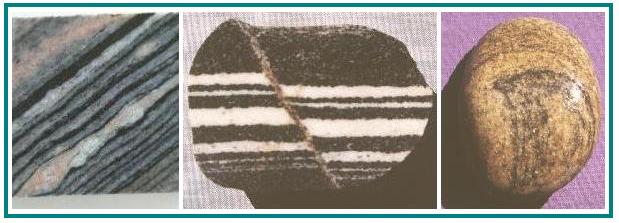( Fr- gneiss; Ger- Gneis;
Nor- gneis; Rus-![]() )
)
GNEISS (See also MIGMATITE)

A. Gneiss paperweight (width - 6.3 cm) made from Randesund banded gneiss from the area east of Kristiansand, southern Norway. R.V. Dietrich collection. (© photo by Dick Dietrich)
B. Gneiss paperweight (width -10 cm) made of faulted gneiss, that consists of alternating black amphibole-rich and white quartz-rich bands; piece is a sliced and polished cobble found in the drift in Isabella County, Michigan. R.V. Dietrich collection. (© photo by Dick Dietrich)
C. Granitic gneiss cobble (greatest dimension - 9.5 cm), given to RVD because it exhibits a "D for Dick", from beach at Whitefish Point, Chippewa County, Michigan. R.V. Dietrich collection. (© photo by Dick Dietrich)
DESCRIPTION: Gneiss (pronounced nīce) has been defined differently by different
geologists. In this document, the following definition
pertains: Gneiss is a roughly foliated or banded
metamorphic rock that consists largely of granular minerals such as
quartz.
Colors - commonly black and white or black
and salmon pink to nearly brick red; less commonly predominantly
diverse green hues, off-white, or dark lilac
H. (effective hardness -- usually due to
quartz content) 7
S.G. 2.5 - 2.7
Light transmission - overall opaque but thin
slices or, for example chips may have parts that are translucent or
even subtransparent
Luster - overall dull, especially on
weathered surfaces, but on freshly broken surfaces individual
constituent mineral grains range from dull, through pearly, to vitreous
Breakage - irregular
Miscellany - predominance of macroscopically
distinguishable granular minerals and rough foliation or banded
appearance are distinctive.
OTHER NAMES: Most geologists
refer to gneisses with either two or three names. Those with two
names are named in accordance with the
scheme whereby ... Gneiss has the ellipsis
replaced a geographic name. The
geographic term is given in accordance with
the
standards
used to name stratigraphic units (see Appendix B, Glossary). The
well-known Baltimore Gneiss of the
Piedmont-Blue Ridge province of the
mid-Atlantic United States is an example. Gneisses with
three names have an additional so-to-speak middle name; that
a dditional part of the name is descriptive and may relate to such
things as the presence of
augen, a banded appearance, the overall lithological identity of the
rock, the presence of a certain mineral, etc., etc. Examples of these
tripartite designations are, respectively, the Little River augen
gneiss, the
Randesund banded gneiss, the Herma granitic gneiss, and the Lynchburg
garnetiferous gneiss, and, so far as the "etc., etc.", other aspects and
examples of the resultant names seem too numerous, and relatively
unecessary, to list here.
OCCURRENCES: Relatively common in metamorphic rock sequences, especially those including rocks with overall granitic compositions. However, the precursor rocks of gneisses may have been sedimentary rocks, volcanic rocks, igneous rocks, migmatites or virtually any combination of those rocks.
NOTEWORTHY LOCALITIES: In metamorphic terranes here and there throughout the world.
REMARKS: This rock name comes from the
German Gneis, which
apparently came about as an alteration of Middle High German gneist, which in turn appears to
have
been derived from the Old
High German word gneisto;
gneist meant
spark so it seems that its application to this rock may have arisen as
a
reference to the "sparkling" appearance that many gneisses exhibit.
As a so-to-speak connoisseur of gneisses (e.g., Dietrich, 1960), a little known fact that has long stuck in my mind since I heard it several decades ago is that Henry A. Ward, founder of Ward's Natural Science Establishment, for many years the major supplier of mineral and rock specimens to schools inter alios, is said to have collected the gneiss pebble, which is preserved at the company headquarters in Rochester, New York, when he was only three years old.
Two gneisses I have seen fashioned into particularly attractive functional ornaments -- i.e., paper weights and bookends -- crop out here and there in the Blue Ridge Province of southwestern Virginia, western North Carolina and eastern Tennessee. One is a handsome overall light gray augen gneiss the feldspar "eyes" of which are all about the same size and distributed evenly throughout the rock; the other is the gneiss with the blue quartz "eyes" that is noted in Appendix A.
In a campaign launched by the Norwegian Broadcasting Corporation (NRK), whereby people were invited to vote (by telephone) for their favorite mountain, Stetind Mountain, Nord, obtained the largest number of votes (Nordgulen, 2002 & Halfdan Carstens, editor of GEO, personal communication, 2002). A fine photograph of this mountain, which consists largely of a granitic gneiss, is shown in Nordgulen's article. As a consequence of the voting, this salient -- which is between Tysfjord and Æfjord (shown as Efjorden on current geographical maps) and about 30 miles (50 km) south of Narvik -- was assigned the title "Norges nasjonalfjell" (Norway's national mountain). One result, I suspect, will be that many tourists will make a point of going to see this striking landmark, and, in turn, it seems likely that entrepreneurs will fashion and market diverse ornamental pieces made from this gneiss.
In literature, several rocks used for such things as beads have been designated gneiss although petrographers would give them other names; one example is amphibolite - see AMPHIBOLITE entry.
SIMULANTS:
***Glass - both Venetian and African glass made to resemble gneiss comprise a bead necklace illustrated by Liu (1995, p.10-11) - [Resemblance is only rough so appearance suffices.].
REFERENCES: No general reference. Dietrich, 1960.
R. V. Dietrich © 2015
Last
update: 8 July 2005
web page created by Emmett Mason